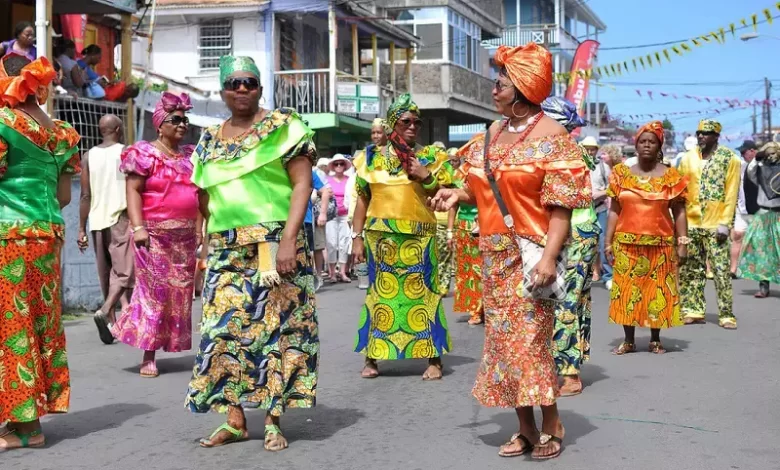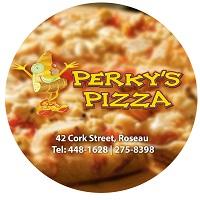Creole Day in Dominica

Creole Day, also known as Jounen Kwéyòl, is one of Dominica’s most significant cultural celebrations. Held annually on the last Friday of October, it is a key highlight of the island’s Creole Heritage Month, which was first celebrated in 1981. The event focuses on preserving and promoting Dominica’s Kwéyòl (Creole) language and rich Cultural Heritage, bringing together Dominica and its visitors in a vibrant celebration of Creole culture through art, cuisine, music, and dance.
Traditional Creole Attire and Symbolism
The Wob Dwiyet, Dominica’s National Dress, plays a central role during Creole Day celebrations. Women wear elegant, flowing dresses made of Madras cloth, representing the blending of African, French, and Indian influences in the island’s history. The Jupe is another typical traditional outfit worn by women during the festivities. Men often wear black pants with a white shirt and Chas (Sash), adding to the colourful display that marks the day. The attire is a celebration of fashion and a reflection of the island’s unique cultural blend.
Private institutions like local fashion designers and cultural groups also participate in the event by showcasing their interpretations of traditional Creole attire, adding a contemporary twist to the age-old designs. Creole Day often hosts competitions and pageants such as the Miss Wob Dwiyet contest, where contestants proudly display traditional dress in various categories.
Dominica’s Creole Music and Dance
Creole music and dance are key elements of Jounen Kwéyòl. Traditional music styles like Bèlè, Quadrille, and Lapo Kabwit are performed throughout the island. These traditional rhythms are integral to Dominica’s Cultural Heritage and are often accompanied by dances that reflect the island’s African and French roots. Schools, cultural groups, and music institutions use the occasion to educate the younger generation about these art forms, ensuring their survival.
The Cultural Division of Dominica, under the Ministry of Tourism, International Transport and Maritime Initiatives, is crucial in organizing Creole Day and the surrounding festivities during Creole Heritage Month. They partner with local artists and musicians to provide performances, concerts, and workshops that showcase the island’s Creole musical heritage.
Creole Cuisine: A Taste of Dominica
Creole Day is also an opportunity to enjoy traditional Dominican cuisine. Creole dishes are prepared using fresh, local ingredients and are heavily influenced by the island’s agricultural heritage. Some popular foods include Callaloo soup, bakes and codfish, smoked herring, fig and codfish, and cassava bread. These dishes blend African, French, and indigenous culinary traditions that have shaped Dominica’s food culture.
Restaurants and private food establishments participate in Creole Day by offering special menus and hosting cooking demonstrations. This attracts locals and tourists alike to indulge in the island’s culinary heritage. The event also encourages cultural tourism, as visitors experience not only the tastes of Dominica but also the stories and traditions behind the island’s food.
Government and Private Support
Both government entities and private institutions contribute to the success of Jounen Kwéyòl. The Ministry of Tourism and the Discover Dominica Authority work closely with schools, community groups, and private sponsors to ensure the event’s success. The government promotes the preservation of Kwéyòl language, working through the Cultural Division to implement language programs and events that allow the local population to connect with their linguistic roots.
Private companies and sponsors, such as food producers and cultural promoters, also play a critical role by sponsoring events, exhibitions, and competitions. This partnership between the public and private sectors ensures that Jounen Kwéyòl is not just a local celebration but a major event on the island’s cultural calendar, attracting visitors worldwide.
Art Exhibitions and Craft Markets
During Creole Day, art exhibitions and craft markets are also common. Local artisans display their work, including traditional Creole-inspired crafts, woven baskets, jewelry, and pottery. These exhibitions are essential for preserving conventional art forms and creating opportunities for local artists to showcase their talents. Cultural institutions such as the Old Mill Cultural Centre often host these art-related events during Creole Heritage Month, fostering creativity and cultural practices preservation.
Promoting Cultural Tourism
Creole Day is a celebration of Dominica’s cultural heritage and a driving force for cultural tourism. The event draws visitors from around the world who come to experience Dominica’s unique traditions. With its blend of music, food, dance, and art, the celebration showcases the island’s deep-rooted Creole culture and creates a memorable experience for tourists while strengthening the island’s cultural identity.




